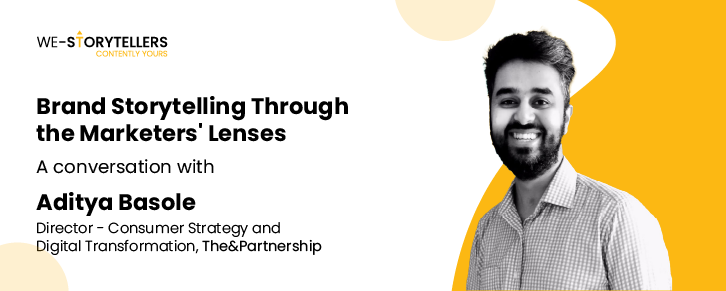A passionate learner, marketer and storyteller, Aditya finds joy in the exploration of change and transformation across industries, geographies, and cultures.
With an extensive background in strategy and branding at JWT, Ogilvy, and iflix/WeTV Malaysia, followed by Lazada in Southeast Asia, he has mastered the science behind marketing while skillfully employing the narrative magic of storytelling.
Our conversation with Aditya Basole delves into brand storytelling from a marketer’s perspective. He takes us to where stories reside and how to bring them to life. Here is an excerpt of our conversation.
Q: What is the role and importance of storytelling in building customer connections?
A: The significance of storytelling in establishing customer connections became clear through my personal experience while researching for an atta brand. Initially, my focus was solely on rational aspects, such as the texture of rotis. However, delving deeper into customer stories uncovered a profound impact on their lives. The societal roles of women in the kitchen influenced not just their cooking experiences but also shaped their self-perception, relationships, and aspirations. This realization highlighted the importance of crafting narratives that go beyond the rational, aiming to resonate with customers on a deeper, emotional level.
Q: How do you think brand storytelling has evolved in the digital age? Are there any notable changes?
A: Storytelling has transformed into an immersive experience. Whether digital or offline, the core of brand storytelling remains unchanged. Earlier, it was about crafting a narrative; now, it’s about creating an interactive journey. Digital platforms have expanded our exposure to diverse stories and its global now. The context might have shifted, but the essence of storytelling—building emotional connections—remains paramount.
Q: How does a brand find its unique storytelling voice? What makes a brand story compelling and memorable?
A: It’s about authenticity and consistency. Your brand’s voice should reflect its values and resonate with the audience. Emotion is pivotal. A compelling story triggers emotions that stay with the audience. It needs a strong central theme, relatable characters, and a journey that engages and resonates. But most importantly, it must evoke emotion, be it joy, empathy, or inspiration.
Q: Who do you think is getting the mix right in brand storytelling today? Could you give us some brand storytelling examples?
A: Nike’s brand storytelling strikes a balance, aligning their brand values with experiences and digital adaptability. They create engaging stories, connecting with consumers beyond ads, showcasing a holistic brand narrative.
Q: MarTech has revolutionized marketing. Do you think it has dampened the creativity of marketing?
A: MarTech has made marketing more accountable and efficient but has yet to diminish creativity. It’s transformed how stories are told across diverse platforms. Context determines story length and engagement.
Q: There’s a common belief that diminishing attention spans in the digital age impact storytelling effectiveness. Do you think attention spans have truly shortened, or is it more about adapting storytelling to capture audience interest amidst multiple screens?
A: Attention spans may be shorter due to multitasking, but storytelling’s effectiveness lies in adapting to the context. Platforms dictate story length, style, and engagement methods. For example, platforms like iflix allowed longer viewing times, enabling brands to tell more authentic and engaging stories. It’s about understanding the context and using storytelling to stand out amidst multiple screens, offering a mix of relevance, authenticity, and emotional connect.
Q: Lastly, what advice would you offer to aspiring marketers looking to enhance their storytelling skills?
A: Embrace empathy and curiosity. To become better storytellers, immerse yourself in diverse experiences, listen to various narratives, and understand human emotions deeply. Learn to translate these emotions into compelling stories that resonate with your audience. Experiment, take risks, and always be curious about how stories shape perceptions and drive connections. Remember, great storytelling isn’t just about the brand; it’s about the people you want to connect with.


